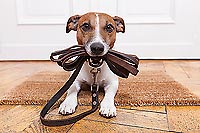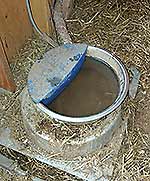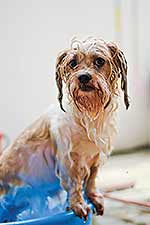As a continuation of last month’s article we are taking a look at some human behaviors that affect and often annoy your canine companion. Are you guilty of any of these interspecies relations faux pas? Read on to find out.
 1. Over or Under Exercise: A walk or two and a game of fetch is all the exercise that’s usually needed for most dogs. But sometimes our lives become too busy, resulting in us skipping these sessions. Without them, your dog can become bored, destructive, despondent, and overweight. The simple solution: commit to a reasonable amount of exercise for your dog each day. The opposite problem can also occur. Fit persons who go for daily runs of several miles often take their dogs with them for company. But extended runs for some dogs are annoying or even harmful, depending on the age, breed-type, and temperament of the dog. An English Bulldog should not be running five miles a day, ever, nor should heavy breeds such as the Mastiff or toy breeds like the Chihuahua. Dogs older than eight should be cleared by a veterinarian before running more than a mile or two. 1. Over or Under Exercise: A walk or two and a game of fetch is all the exercise that’s usually needed for most dogs. But sometimes our lives become too busy, resulting in us skipping these sessions. Without them, your dog can become bored, destructive, despondent, and overweight. The simple solution: commit to a reasonable amount of exercise for your dog each day. The opposite problem can also occur. Fit persons who go for daily runs of several miles often take their dogs with them for company. But extended runs for some dogs are annoying or even harmful, depending on the age, breed-type, and temperament of the dog. An English Bulldog should not be running five miles a day, ever, nor should heavy breeds such as the Mastiff or toy breeds like the Chihuahua. Dogs older than eight should be cleared by a veterinarian before running more than a mile or two.
If you want to run with your dog, be sure she is of a breed-type able to do so. Worn pads and structural issues can lead to medical intervention and shortened lives. Finding a nice balance of exercise for your dog is the key: remember, it’s for them, not you. In general, if your dog is lagging behind, you’ve taken them too far.
2. Incomprehensible Requests: Dogs definitely understand words associated with certain actions, behaviors, and things, but do not get grammar, syntax, or abstract meaning. Nevertheless, we often talk to our dogs at length, thinking that they get what we are asking them to do. This is, of course, totally fine unless you’re trying to communicate what you’d like them to do. Apart from enjoying the tone of our voices, our dogs don’t often get what we are driving at. They are much better at reading body language or keying in on specific words. Be precise with words and tone and always use body posture (think hand signals, such as a hand in the air to request a lie down, or crouching to request “come”, or running away to get your dog to accompany you) whenever possible. Communicate exactly what you want, without confounding your pooch and leaving them at a loss as to what you’d like of them. Our dogs aim to please; our job is to give them the tools to do so in a simple and direct way.
3. Forced Socialization: If your dog is happy to be introduced to new people and pets, then by all means, let them enjoy interacting. If they are reserved and anxious, forcing them to interact can be annoying or even dangerous. Allow your dog to decide when they want to come over to investigate a new person.
When introducing your not-super-social dog to a new dog, instead of throwing them together, opt for going for a group walk before a dog-to-dog greeting. Form a single-file line with three or four dog/human teams and simply walk around the block. This creates a team feeling among the dogs and slowly desensitizes them to group encounters. After a few blocks, if you think your dog is comfortable enough to greet, go for it. Just never force them to interact: instead, let their demeanor guide your actions.
 4. Dirty Water: In addition to collecting dust, food bits, hair, and other undesirable flotsam and jetsam, your dog’s water can become contaminated with bacteria or other contagions, especially if other dogs drink from it. Outdoor bowls can be especially vulnerable to contamination or to a forgetful person allowing them to go dry. Fetid water or a dry bowl is a sure way to annoy a thirsty dog. Every day, clean then refill your dog’s water bowls with fresh water. If a new dog comes to visit, provide it with a separate bowl, to prevent infections from passing to your pet. 4. Dirty Water: In addition to collecting dust, food bits, hair, and other undesirable flotsam and jetsam, your dog’s water can become contaminated with bacteria or other contagions, especially if other dogs drink from it. Outdoor bowls can be especially vulnerable to contamination or to a forgetful person allowing them to go dry. Fetid water or a dry bowl is a sure way to annoy a thirsty dog. Every day, clean then refill your dog’s water bowls with fresh water. If a new dog comes to visit, provide it with a separate bowl, to prevent infections from passing to your pet.
5. Manhandling: Children are fast, unpredictable, and impulsive, and can often worry or annoy a dog, especially one unused to their unpredictable and exuberant natures. Kids might chase, pull on ears or tails, try to ride a big dog or even take away a toy. Any of these can result in a bite to the hands or face. Before you have children over, talk to their parents first, so they can explain protocol to the youngsters. When they come over, let your dog greet them casually, and have them give them a treat or two. Then, simply maintain a calm atmosphere. If the children want to play hard and your dog seems concerned, put them in a room that’s off-limits to the kids.
6. Too Much Noise: According to a Louisiana State University study, dogs have a range of hearing nearly twice that of humans. This allows them to hear much higher sounds than us, which is why playing entertainment devices too loudly can cause dogs to seek out a far corner of the home for peace and quiet. Even a loud, boisterous crowd watching a sports event on TV can create anxiety in some dogs. Respect your dog’s sensitivity to sound, and keep radios, televisions, and other noise producing devices set to a reasonable volume. If you’re having a party with loud music, move your dog as far from the noise as possible.
 7. Too Many Baths: No one wants a smelly dog in their home. But dogs were not meant to be bathed as often as humans bathe. If their skin and coat are robbed of their natural oils too often, both will become dry and unhealthy. Dry skin can lead to chronic scratching, hot spots or full-on dermatitis. Most dogs don’t like to be bathed, because it requires them to have their bodies soaked down and handled while they remain vulnerable. Most dogs dislike having their feet and legs handled, and despise getting soap in their eyes. Plus, many people fail to use warm enough water when bathing their dogs. 7. Too Many Baths: No one wants a smelly dog in their home. But dogs were not meant to be bathed as often as humans bathe. If their skin and coat are robbed of their natural oils too often, both will become dry and unhealthy. Dry skin can lead to chronic scratching, hot spots or full-on dermatitis. Most dogs don’t like to be bathed, because it requires them to have their bodies soaked down and handled while they remain vulnerable. Most dogs dislike having their feet and legs handled, and despise getting soap in their eyes. Plus, many people fail to use warm enough water when bathing their dogs.
If he smells or is clearly dirty, then go for it. But don’t schedule a weekly bath just because you think it’s appropriate. Instead, brush and comb your dog daily. This allows you to remove dirt, dead hair, and skin. When you do bathe your dog, brush and comb first to remove tangles, use warm water and a mild dog-formulated shampoo, like Earth Bath Shampoo.
8. Dinner Time Interruptions: You should of course be able to pick up the doggy dish when necessary without any resistance from your dog, so teach them that picking up the dish will always result in a good consequence. With the dish empty first, pick up the dish, place a treat in it, and put it down. Repeat this often. Then randomly do the same while your dog is eating. But once this behavior is well established, minimize dish handling and let your pooch feast. If someone kept touching your plate during dinner, you’d get annoyed, once your dog begins to eat, respect their bliss and let them be. |